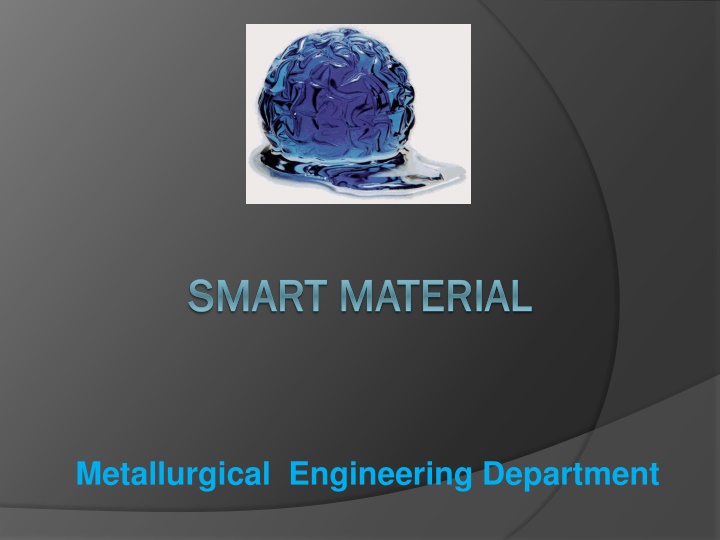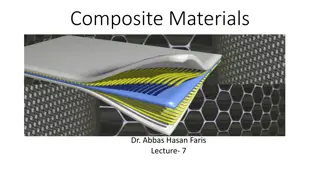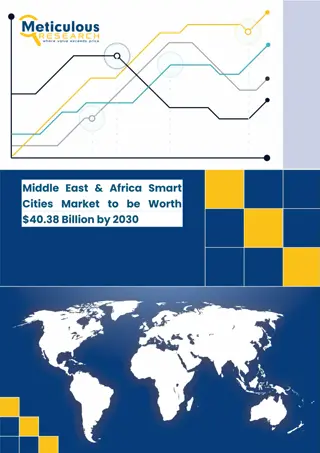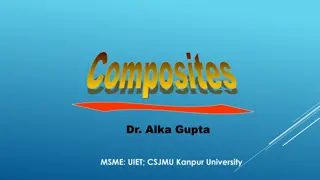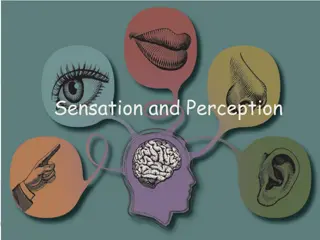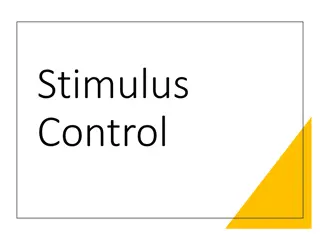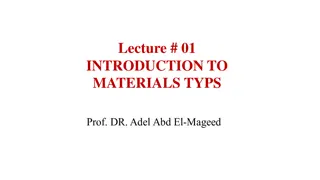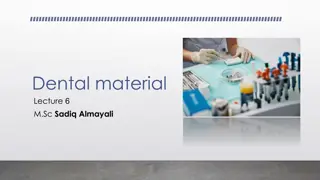Smart Materials: Changing Properties with External Stimuli
Smart materials exhibit properties that can be altered by external stimuli like stress, temperature, and magnetic fields. These materials, such as piezoelectric and magneto-rheostatic materials, have diverse applications and are continuously researched for further advancements in various fields.
Uploaded on Mar 17, 2025 | 0 Views
Download Presentation

Please find below an Image/Link to download the presentation.
The content on the website is provided AS IS for your information and personal use only. It may not be sold, licensed, or shared on other websites without obtaining consent from the author.If you encounter any issues during the download, it is possible that the publisher has removed the file from their server.
You are allowed to download the files provided on this website for personal or commercial use, subject to the condition that they are used lawfully. All files are the property of their respective owners.
The content on the website is provided AS IS for your information and personal use only. It may not be sold, licensed, or shared on other websites without obtaining consent from the author.
E N D
Presentation Transcript
SMART MATERIAL SMART MATERIAL Metallurgical Engineering Department
What is Smart materials? The materials have the ability to change shape or size simply by adding a little bit of heat, or to change from a liquid to a solid almost instantly when near a magnet; these materials are called smart materials smart material with variable viscosity may turn from a fluid which flows easily to a solid
A variety of smart materials already exist, and are being researched extensively. i.e. Piezoelectric materials Magneto-rheostatic material Electro-rheostatic materials Shape memory alloys. (coffeepots, cars, the International Space Station, eyeglasses) and the number of applications for them is growing steadily.
Smart Smart materials have one or more properties that can be significantly changed in a controlled fashion by external stimuli, such as stress, temperature, magnetic fields. materials or designed designed materials materials are materials that moisture, pH, electric or
Piezoelectric Piezoelectric materials voltage when stress is applied. Since this effect also applies in the reverse manner, a voltage across the sample will produce stress within the sample. Suitably designed structures made from these materials can therefore be made that bend, expand or contract when a voltage is applied. materials are materials that produce a used to measure fluid compositions, fluid density fluid viscosity force of an impact.
Magneto Magneto- -rheostatic rheostatic rheostatic materials rheostatic material & Electro material & Electro- - materials Electro-rheostatic (ER) and magneto-rheostatic (MR) materials are fluids, which can experience a dramatic change in their viscosity These fluids can change from a thick fluid (similar to motor oil) to nearly a solid substance within the span of a millisecond when exposed to a magnetic or electric field; the effect can be completely reversed just as quickly when the field is removed.
The MR fluid is liquid as shown on the left, when no magenetic field is present, but turns solid immediately after being placed in a magnetic field on the right.
Application of MR & ER Materials MR fluids are being developed for use in car shocks, damping washing machine vibration, prosthetic limbs, exercise equipment, and surface polishing of machine parts. ER fluids have mainly been developed for use in clutches and valves, as well as engine mounts designed to reduce noise and vibration in vehicles
Shape Shape- -memory materials in which large deformation can be induced and recovered through temperature changes or stress changes (pseudo elasticity). memory alloys alloys and shape-memory polymers are The large deformation results due to martensitic phase change.
The two main types of shape-memory alloys are the copper-aluminium-nickel, nickel-titanium (NiTi) alloys This material is a lightweight Solid-state alternative to conventional actuators such as hydraulic, pneumatic, and motor-based systems. Shape-memory alloys have applications in industries including medical and aerospace
Materials Alloys of metals having the memory effect at different temperatures and at different percentages of its solid solution contents. Ag-Cd 44/49 at.% Cd Au-Cd 46.5/50 at.% Cd Cu-Al-Ni 14/14.5 wt.% Al and 3/4.5 wt.% Ni Cu-Sn approx. 15 at.% Sn Cu-Zn 38.5/41.5 wt.% Zn Cu-Zn-X (X = Si, Al, Sn) Fe-Pt approx. 25 at.% Pt Mn-Cu 5/35 at.% Cu Fe-Mn-Si Pt alloys Co-Ni-Al Co-Ni-Ga Ni-Fe-Ga
Application of Shape memory alloy Aircraft Boeing, General Electric Aircraft Engines, Goodrich Corporation, NASA, and All Nippon Airways developed the Variable Geometry Chevron using shape-memory alloy that reduces aircraft's engine noise. shape-memory coupling orthopaedic surgery, dental braces Eyeglass frames
pH pH- -sensitive polymers sensitive polymers are materials that change in volume when the pH of the surrounding medium changes.
Temperature Temperature- -responsive which undergo changes upon temperature. responsive polymers polymers are materials
Halochromic Halochromic materials used materials that change their color as a result of changing acidity. materials are commonly Application is for paints that can change color to indicate corrosion in the metal underneath them.
Chromogenic systems Chromogenic systems change color in response to electrical, optical or thermal changes. These include electro chromic materials, which change their color or opacity on the application of a voltage (e.g., liquid crystal displays), thermo chromic materials change in color depending on their temperature, and photo chromic materials, response to light for sunglasses that darken when exposed to bright sunlight. which example, change light color sensitive in
Photomechanical Photomechanical exposure to light. materials materials change shape under
Self Self- -healing materials healing materials have the intrinsic ability to repair damage due to normal usage, thus expanding the material's lifetime
Dielectric elastomers Dielectric elastomers (DEs) systems which produce large strains (up to 300%) under the influence of an external electric field. (DEs) are smart material Pumps Valves Robotics Power Generation Active Vibration Control of Structures Optical Positioners such for auto-focus, zoom, image stabilization Sensing of force and pressure Active Braille Displays Speakers Deformable surfaces for optics and aerospace
Thermoelectric materials Thermoelectric materials are used to build devices that convert temperature differences into electricity and vice-versa two commonly employed combinations are 1. iron and constantan 2. Chromel (an alloy of chromium and nickel ) and alumel an alloy of aluminum and nickel
